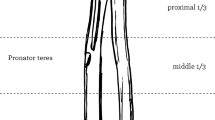Abstract
Introduction
The belief that not all distal radius fractures can be initially anatomically reduced with conservative means is rising. The aim of this study was to examine whether adequate reduction with a closed reduction technique is possible and to assess the importance of each step.
Materials and methods
We prospectively enrolled 63 distal radius fractures (62 patients). A standardized reduction technique was implemented. Reduction was radiologically evaluated in hanging traction, after reduction, and in plaster. Subgroup analysis was performed for fracture-dependent and fracture-independent factors on their influence on reduction.
Results
The mean radiological values (radial inclination, dorsal tilt, ulnar variance) showed near anatomic reduction of all fractures in plaster. Fracture severity according to AO classification, initial displacement, number of instability criteria and patient age did not affect the reduction outcome.
Conclusions
All types of enrolled fractures were nearly anatomically reduced. This contradicts the opinion that some “severe” fractures are too unstable to be initially reduced by closed means.





Similar content being viewed by others
References
de Putter CE, Selles RW, Polinder S, Hartholt KA, Looman CW, Panneman MJ, Verhaar JA, Hovius SE, van Beeck EF (2012) Epidemiology and health-care utilisation of wrist fractures in older adults in The Netherlands, 1997–2009. Injury. doi:10.1016/j.injury.2012.10.025
Diaz-Garcia RJ, Chung KC (2012) Common myths and evidence in the management of distal radius fractures. Hand Clin 28(2):127–133. doi:10.1016/j.hcl.2012.02.005
Bales JG, Stern PJ (2012) Treatment strategies of distal radius fractures. Hand Clin 28(2):177–184. doi:10.1016/j.hcl.2012.02.003
Gluck JS, Chhabra AB (2012) Loss of alignment after closed reduction of distal radius fractures. J Hand Surg Am. doi:10.1016/j.jhsa.2012.08.001
Meier R, Krettek C, Probst C (2012) Treatment of distal radius fractures. Percutaneous Kirschner-wires or palmar locking plates? Unfallchirurg 115(7):598–605. doi:10.1007/s00113-012-2180-5
Böhler L (ed) (1953) Technik der Knochenbruchbehandlung. 12. und 13.Aufl.Maudrich, Wien
Charnley J (ed) (1968) Die konservative Therapie der Extremitätenfrakturen. Springer, Berlin
Jahna H, Wittich H (1985) Konservative Methoden in der Frakturbehandlung. Urban & Schwarzenberg, Wien
Liporace FA, Adams MR, Capo JT, Koval KJ (2009) Distal radius fractures. J Orthop Trauma 23(10):739–748. doi:10.1097/BOT.0b013e3181ba46d3
Mackenney PJ, McQueen MM, Elton R (2006) Prediction of instability in distal radial fractures. J Bone Jt Surg Am 88(9):1944–1951. doi:10.2106/jbjs.d.02520
Leone J, Bhandari M, Adili A, McKenzie S, Moro JK, Dunlop RB (2004) Predictors of early and late instability following conservative treatment of extra-articular distal radius fractures. Arch Orthop Trauma Surg 124(1):38–41. doi:10.1007/s00402-003-0597-6
Gartland JJ Jr, Werley CW (1951) Evaluation of healed Colles’ fractures. J Bone Jt Surg Am 33(4A):895–907
Lafontaine M, Hardy D, Delince P (1989) Stability assessment of distal radius fractures. Injury 20(4):208–210
Frykman G (1967) Fracture of the distal radius including sequelae—shoulder–hand–finger syndrome, disturbance in the distal radio-ulnar joint and impairment of nerve function. A clinical and experimental study. Acta Orthop Scand Suppl 108:103
Cooney WP 3rd, Linscheid RL, Dobyns JH (1979) External pin fixation for unstable Colles’ fractures. J Bone Jt Surg Am 61(6A):840–845
Lafontaine M, Delince P, Hardy D, Simons M (1989) Instability of fractures of the lower end of the radius: apropos of a series of 167 cases. Acta Orthop Belg 55(2):203–216
Nesbitt KS, Failla JM, Les C (2004) Assessment of instability factors in adult distal radius fractures. J Hand Surg Am 29(6):1128–1138. doi:10.1016/j.jhsa.2004.06.008
Solgaard S (1986) Early displacement of distal radius fracture. Acta Orthop Scand 57(3):229–231
Altissimi M, Mancini GB, Azzara A, Ciaffoloni E (1994) Early and late displacement of fractures of the distal radius The prediction of instability. Int Orthop 18(2):61–65
Abbaszadegan H, Jonsson U, von Sivers K (1989) Prediction of instability of Colles’ fractures. Acta Orthop Scand 60(6):646–650
Pechlaner S, Gabl M, Lutz M, Krappinger D, Leixnering M, Krulis B, Ulmer H, Rudisch A (2007) Distal radius fractures—aetiology, treatment and outcome. Handchir Mikrochir Plast Chir 39(1):19–28. doi:10.1055/s-2007-964920
Einsiedel T, Freund W, Sander S, Trnavac S, Gebhard F, Kramer M (2009) Can the displacement of a conservatively treated distal radius fracture be predicted at the beginning of treatment? Int Orthop 33(3):795–800. doi:10.1007/s00264-008-0568-1
Neidenbach P, Audige L, Wilhelmi-Mock M, Hanson B, De Boer P (2010) The efficacy of closed reduction in displaced distal radius fractures. Injury 41(6):592–598. doi:10.1016/j.injury.2009.10.055
Conflict of interest
The authors declare that they have no conflict of interest.
Author information
Authors and Affiliations
Corresponding author
Rights and permissions
About this article
Cite this article
Wichlas, F., Haas, N.P., Lindner, T. et al. Closed reduction of distal radius fractures: does instability mean irreducibility?. Arch Orthop Trauma Surg 133, 1073–1078 (2013). https://doi.org/10.1007/s00402-013-1758-x
Received:
Published:
Issue Date:
DOI: https://doi.org/10.1007/s00402-013-1758-x




